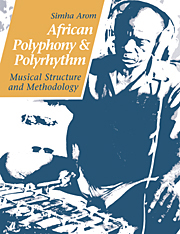Book contents
- Frontmatter
- Contents
- List of illustrations
- Foreword by György Ligeti
- Preface
- Acknowledgements
- BOOK I THE MUSIC OF THE CENTRAL AFRICAN REPUBLIC
- BOOK II AFRICAN POLYPHONIC MUSIC
- BOOK III TECHNICAL TOOLS: METHODS OF RECORDING POLYPHONIC MUSIC FOR TRANSCRIPTION
- BOOK IV THEORETICAL TOOLS
- 1 The notion of relevance
- 2 Description and analysis
- 3 The question of transcription
- BOOK V THE ORGANISATION OF TIME IN AFRICAN MUSIC
- BOOK VI STRUCTURAL PRINCIPLES AND THEIR APPLICATION
- Conclusion
- Bibliography
1 - The notion of relevance
Published online by Cambridge University Press: 27 January 2010
- Frontmatter
- Contents
- List of illustrations
- Foreword by György Ligeti
- Preface
- Acknowledgements
- BOOK I THE MUSIC OF THE CENTRAL AFRICAN REPUBLIC
- BOOK II AFRICAN POLYPHONIC MUSIC
- BOOK III TECHNICAL TOOLS: METHODS OF RECORDING POLYPHONIC MUSIC FOR TRANSCRIPTION
- BOOK IV THEORETICAL TOOLS
- 1 The notion of relevance
- 2 Description and analysis
- 3 The question of transcription
- BOOK V THE ORGANISATION OF TIME IN AFRICAN MUSIC
- BOOK VI STRUCTURAL PRINCIPLES AND THEIR APPLICATION
- Conclusion
- Bibliography
Summary
WHAT IS RELEVANCE?
Having developed a method and shown it to be well-founded, we now have the technique we need to transcribe and analyse polyphony. We can record unwritten polyphonic music part by part, and our recordings enable us to see how the parts combine and interlock. They thus provide the raw material for further research; however, analysis as such cannot begin without a transcription.
We now come to a fundamental methodological question. Do we want a rational and meaningful transcription based on the way the people who use the music perceive and understand it, i.e., do we really want to follow through with our stated purpose of setting aside whatever Western notions we might be tempted to project onto African music? If so, before we actually start to transcribe, we must develop another device to enable us to determine what we can and ought to extract from our recorded material. Referring only to criteria present in the musical tradition under study, the investigator should be able to decide which data in the raw material are meaningful, and which are not. We therefore require a device like a sequence of filters, which can separate out whatever is meaningful. This device must operate on the basis of the notion of relevance.
The musicologist has, in fact, a choice of two alternatives. He may remain as close to the recorded material as he can and try to note every detail with maximal accuracy. This approach, while apparently convincing from the acoustic standpoint, nevertheless suffers from the fact that there is no limit of ultimate accuracy, as transcriptions like Bartók's have shown. The other possibility would be to try to determine beforehand what the members of the community consider to be meaningful in their own music.
- Type
- Chapter
- Information
- African Polyphony and PolyrhythmMusical Structure and Methodology, pp. 137 - 157Publisher: Cambridge University PressPrint publication year: 1991

